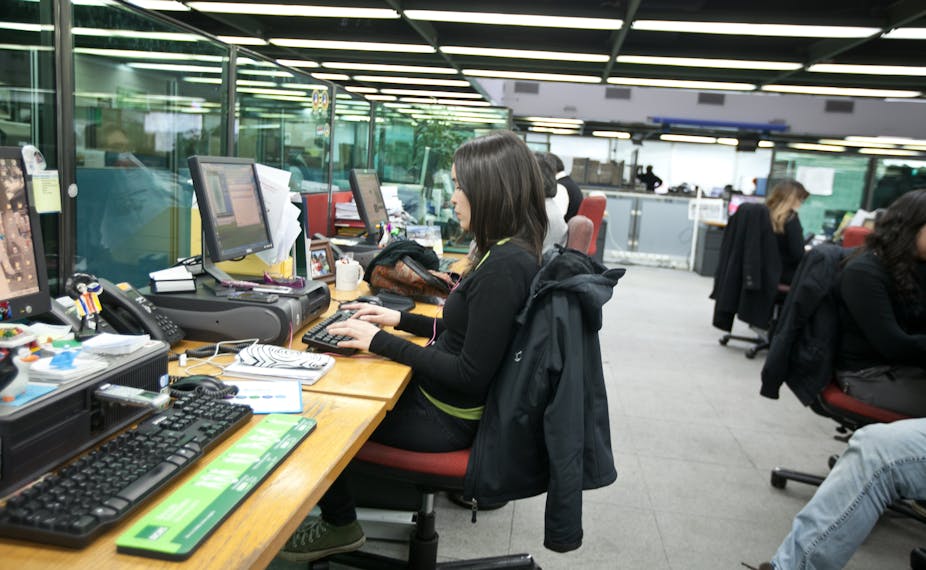Many of the men I knew who ran newsrooms in the 80s and 90s were womanisers, drunks, bullies, and gropers. Some were just sleazy.
And any woman, of almost any ambition, was cold or bossy or had too many family responsibilities.
These men were chiefs-of-staff or news editors, very occasionally the senior editors themselves. Those who had the title of editor-in-chief had either pulled themselves together or had never been that way in the first place. Usually.
The occasional woman from that time stayed in the job (congratulations, Judith Whelan, on your position as news director at Fairfax).
And the sleazebuckets got away with keeping the titles and senior positions despite these deep and serious character flaws. Talented women left in droves, frozen out by those same witless men.
In 2014, the media landscape has been transformed in so many ways, and yet those accusations about women haven’t changed much. Both Jill Abramson, the executive editor of the New York Times newspaper, and Natalie Nougayrède, editor-in-chief of the French title Le Monde, have both been forced out of their jobs in the last three days, amid accusations of authoritarianism and controlling behaviour. They are, fortunately, both a little too old to be criticised for wanting to get home to the kids.
They were the first women to hold those senior positions at their publications.

And, as a result of this recent news, Julie Posetti, a lecturer at the University of Wollongong, research fellow at the World Association of Newspapers and News Publishers (WAN-IFRA) and the World Editors Forum based in Paris, has been forced to redraft Trends in Newsrooms, a book she is writing as part of her year-long fellowship.
“We’re about to go to press but I’m having to re-write the chapter which identified a positive global shift on gender equality on top titles in the wake of the upheaval at Le Monde and the NYT,” she told me.
“This underlines the entrenched nature of inequality at the top of our industry and indicates the fragility of progress.
"These developments are so very disheartening,” said Posetti.
In Australia, our firsts took place somewhat earlier than those at either Le Monde or the New York Times.
Cathy Harper was the first female chief-of-staff at the Sydney Morning Herald in 1982. The chief political correspondent at The Conversation, Michelle Grattan, was my editor when I worked at the Canberra Times in 1994 but was forced out in about 12 months. Amanda Wilson was the editor of the Sydney Morning Herald for just 18 months.

In Australia, as I mentioned earlier, we have our first female news director in the person of Judith Whelan; and utterly/ appropriately terrifying anchors of current affairs programs, such as Leigh Sales and Sarah Ferguson. But in the research Professor Wendy Bacon, Julie Posetti and I did for New Matilda in 2013, we found an overwhelmingly male hierarchy in news media, online, in print, in broadcast.
We aren’t – right now – hearing details of senior female journalists in Australia being boned. And the managing editor of the Sun-Herald, Kate Cox, told me that she thinks newsrooms in Australian have changed.
She says that she has had no experience of men challenging her authority; as soon as you can prove you can handle crises, the doubt vanishes.

She told me, however, that there is a serious structural issue for women in newsrooms – and maybe for all workplaces:
The issue is getting women to take the jobs and getting them to keep them … It took [Fairfax] a long time to convince me to do this job. I would give reasons why I wouldn’t do it.
A lot of the time a man would give ten reasons why they can.

Cox says that when Garry Linnell was persuading her to take her role, he said that when a vacancy came up, there would be a queue of men outside his office explaining why they would be perfect for the role. And no women.
But she also acknowledges the existence of the gender pay gap in media organisations and in western countries.
And that, rumour says, is one of the reasons why Abramson got the flick. She discovered her predecessor earned more than she did.
Convenor of the newly formed Women in Media, a nationwide networking and mentoring initiative supported by the Walkley Foundation for Journalism and MEAA, Tracey Spicer, told me:
One of the reasons Jill Abramson was pushed off the glass cliff was because she dared to question the gender pay gap. This has all the hallmarks of a gendered execution [and] it’s particularly resonant in Australia, a country in which no woman has been editor of the national broadsheet.
Spicer, author of the lively antidote to male behaviour in news media, Dear Mr Misogynist, says what happened to Abramson – and women everywhere – illustrates the need for organisations such as Women in Media:
Those few women who manage to make it to the top are inevitably accused of being “pushy” … surely that is a requirement of the editor of a newspaper? Apparently only men are allowed to be pushy.
But perhaps Ann Friedman, writing this week in the New York Magazine sums it up best:
Women never know whether they’re being met with a hostile reaction because of their performance — something that they can address and change — or because of both male and female colleagues’ internalised notions of how women should behave. I’ve asked these questions about my own career: Am I struggling because I’m not playing the game well enough, or because the game is rigged against me?

